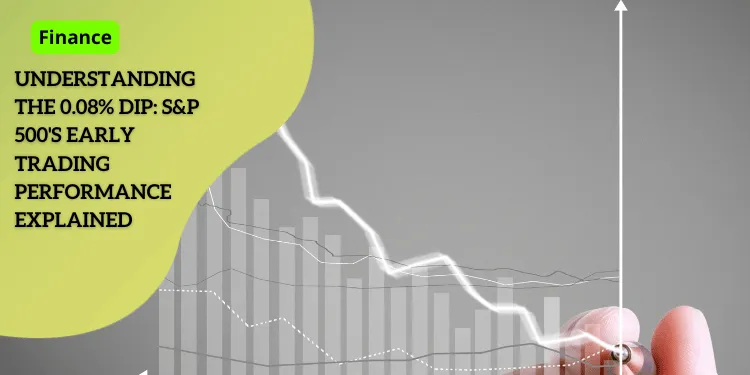Understanding the 0.08% Dip: S&P 500’s Early Trading Performance Explained

Anúncios
The S&P 500, also known as the Standard & Poor’s 500, is a prominent stock market index.
It measures the performance of 500 large companies listed on U.S. stock exchanges.
Anúncios
Established in 1957, it has since become a pivotal benchmark for gauging U.S. market performance.
A market-capitalization-weighted index, the S&P 500 tracks approximately 80% of the total U.S. market capitalization.
Anúncios
This weighting means that larger companies have a more significant impact on the index’s performance.
Importance as a Benchmark
The S&P 500 is not just a tool for investors and analysts; it serves as a benchmark for a variety of investment products.
Its comprehensive representation of the U.S. economy, encompassing all 11 Global Industry Classification Standard sectors, makes it a reliable indicator of market trends.
This index has surpassed the Dow Jones Industrial Average in popularity because of its extensive and inclusive design.
Finance professor Derek Horstmeyer from George Mason University highlights its significance: “The S&P 500 has become the most widely used benchmark over the past 50 years due to its ability to serve as the best indicator for U.S. markets”.
Current Year-to-Date Performance
As of today, the S&P 500 has shown a robust year-to-date performance, up by 20.08%.
This performance underscores the index’s resilience and its role as a global investment benchmark.
Despite minor fluctuations, such as the 0.08% decline in early trading today, the index continues to reflect the overall health and dynamics of the U.S. stock market.
Understanding the S&P 500’s structure and criteria is crucial for investors looking to navigate the financial landscape effectively.
Today’s Opening Performance
The S&P 500 opened at 5,698.14 today.
Within the first 30 minutes of trading, it experienced a modest decline of 0.08%, settling at 5,693.50.
Despite this small dip, the year-to-date performance remains strong with a return of 20.08%.
Analyzing the Modest Dip
Let’s break down what this 0.08% decline means.
A drop of 4.64 points is relatively minor, especially given the index’s impressive performance so far this year.
Market fluctuations of this magnitude are quite common and can be influenced by a variety of factors, such as economic data releases, geopolitical events, or market sentiment.
It’s essential to view this dip within the broader context.
The S&P 500 is a market-capitalization-weighted index, representing around 80% of the total U.S. market capitalization.
Such a minor movement does not significantly impact the overall positive trend observed over the year.
By understanding the nature of market volatility, investors can better interpret these small day-to-day changes as part of the bigger picture, rather than as isolated events warranting drastic reactions.
This perspective helps maintain a long-term investment strategy and prevents knee-jerk responses that could undermine potential gains.
Composition and Structure of the S&P 500
Market-Capitalization Weighted Index
The S&P 500 is a market-capitalization weighted index, meaning the size of each company in the index is proportional to its market capitalization.
This structure ensures that larger companies have a more significant influence on the index’s performance.
For example, giants like Apple and Microsoft hold more weight than smaller companies, giving a more accurate snapshot of the market’s overall health.
Representation of 11 Global Industry Classification Standard Sectors
The S&P 500 comprises companies from all 11 sectors classified under the Global Industry Classification Standard (GICS).
These sectors include:
- Information Technology
- Health Care
- Financials
- Consumer Discretionary
- Communication Services
- Industrials
- Consumer Staples
- Energy
- Utilities
- Real Estate
- Materials
This broad representation makes the S&P 500 a comprehensive reflection of the U.S. economy, encompassing various industries and sectors.
Top Companies in the Index by Market Capitalization
The top companies in the S&P 500 are often the largest and most influential firms in the market.
As of the latest data, some of the biggest names include:
- Apple (AAPL)
- Microsoft (MSFT)
- Amazon (AMZN)
- Alphabet (GOOG)
- Facebook (FB)
These companies not only dominate the index but also lead their respective sectors, making significant contributions to the overall performance of the S&P 500.
Understanding the composition and structure of the S&P 500 provides crucial insight into its behavior and performance, setting the stage for further exploring its historical resilience and enduring significance.
Inclusion Criteria for the S&P 500
Understanding the composition of the S&P 500 requires knowing the strict set of criteria that companies must meet to be included in this prestigious index.
These criteria ensure that the S&P 500 remains a reliable gauge of U.S. market performance and a vital tool for investors.
Minimum Unadjusted Market Capitalization Requirement
One of the key criteria for inclusion in the S&P 500 is meeting the minimum unadjusted market capitalization requirement.
To be considered, a company must have an unadjusted market capitalization of at least $14.5 billion.
This high threshold helps ensure that only large, stable companies are included, contributing to the index’s reliability as a market benchmark.
Financial Viability and Positive Earnings Criteria
Financial health is another critical criterion.
Companies must exhibit financial viability, which is assessed through their earnings.
Specifically, a company must have positive earnings for the most recent quarter as well as the sum of its earnings over the past four quarters.
This requirement ensures that the companies included in the S&P 500 are profitable and have a track record of financial stability, further solidifying the index’s role as a reliable market indicator.
Liquidity and Trading Volume Requirements
Liquidity is essential for a stock to be included in the S&P 500.
The ratio of the annual dollar value traded to float-adjusted market capitalization must be at least 0.75.
This ratio indicates that a substantial portion of the company’s publicly available shares are actively traded, making it easier to buy or sell the stock without significantly impacting its price.
Additionally, the stock must have traded at least 250,000 shares in the six months leading up to the evaluation date, ensuring that it is accessible to investors.
These stringent criteria help maintain the integrity of the S&P 500 as a market benchmark, ensuring that it continues to reflect the health and performance of the U.S. economy.
The inclusion rules shine a light on the resilience needed to be part of such a critical index.
This groundwork ultimately aids in understanding the historical significance and market behavior of the S&P 500.
Historical Performance and Significance
Brief History of the S&P 500
The S&P 500 index, or Standard & Poor’s 500, has held a pivotal role in the financial world since its inception on March 4, 1957.
Managed by Standard & Poor’s, it was designed to measure the performance of 500 of the largest companies listed on U.S. stock exchanges, providing a comprehensive snapshot of the U.S. equity market.
Its history, however, dates back to 1923 with a predecessor index tracking just 233 companies, which evolved into the more robust S&P 500 we recognize today.
Resilience Through Economic Cycles and Market Crashes
The S&P 500 has demonstrated remarkable resilience through numerous economic cycles and market downturns.
For instance, during the dot-com bubble bursting in the early 2000s, the index saw declines of 10.14% in 2000, 13.04% in 2001, and a staggering 23.37% in 2002.
More recently, during the Great Recession of 2008, the S&P 500 plunged by 39.23%.
Despite these significant drawdowns, the S&P 500 has managed to recover and continue its upward trajectory.
This resilience is a testament to the underlying strength of its constituent companies and the broader U.S. economy.
Role as a Global Investment Benchmark
Today, the S&P 500 stands as one of the most trusted benchmarks for global investors.
Its market-capitalization-weighted structure, which assigns more weight to larger companies, allows it to accurately reflect the performance of the U.S. equity market.
The index includes companies from all 11 sectors of the Global Industry Classification Standard (GICS), offering a diversified representation of the economy.
The prominence of companies like Apple, Microsoft, and Amazon underscores its importance as a global investment reference point.
Investors and analysts alike rely on the S&P 500 to gauge market health, strategize trading moves, and compare the performance of their portfolios.
As we delve deeper into the inclusion criteria for the S&P 500, it becomes clear why this index holds such a prestigious place in the financial world.
Investment Options in the S&P 500
Index Funds and ETFs
Investing in the S&P 500 is accessible through various financial products, with index funds and Exchange-Traded Funds (ETFs) being the most popular choices.
Index Funds
Index funds are mutual funds designed to replicate the performance of the S&P 500.
They pool money from multiple investors to purchase the stocks in the index, mirroring its composition and weightings.
A prominent example is the Vanguard 500 Index Fund Admiral Shares (VFIAX).
These funds are advantageous for long-term investors due to their passive management and typically lower fees compared to actively managed funds.
ETFs
ETFs, like index funds, aim to track the S&P 500 but can be traded on stock exchanges throughout the day, similar to individual stocks.
One commonly used ETF is the SPDR S&P 500 ETF Trust (SPY).
ETFs generally have lower fees than mutual funds, making them a cost-effective option for investors looking for flexibility and liquidity.
Options and Futures Contracts
For advanced investors, options and futures contracts on the S&P 500 provide more intricate investment strategies.
Options Contracts
Options give investors the right, but not the obligation, to buy or sell the S&P 500 at a predetermined price before a specific expiration date.
These can be used for hedging or speculative purposes, offering the potential for high returns but also carrying significant risks.
Futures Contracts
Futures contracts obligate investors to buy or sell the S&P 500 at a set price at a specific future date.
These contracts, introduced by the Chicago Mercantile Exchange in 1982, can be used for hedging against market movements or speculating on future price changes.
They are electronically traded and highly liquid, adding another layer of complexity to investment strategies.
Considerations for Different Investment Vehicles
Choosing the right investment vehicle involves weighing various factors:
- Fees: ETFs generally have lower fees than mutual funds.
- Flexibility: ETFs offer intra-day trading, while index funds are only traded at the day’s closing price.
- Risk: Options and futures provide opportunities for higher returns but come with greater risks and require more sophisticated strategies.
- Investment Horizon: Long-term investors might lean towards index funds and ETFs for their stability, while short-term traders or those looking for leverage might prefer options and futures.
By understanding the different investment options available, investors can align their strategies with their financial goals and risk tolerance, ensuring effective participation in the S&P 500.
Understanding these investment mechanisms provides a foundation for insightful market participation.
Conclusion and Market Outlook
Today’s modest 0.08% dip at the opening of the S&P 500 may seem trivial, but its context within broader market trends is revealing.
One of the significant factors influencing this dip could be temporary market sentiment driven by short-term traders.
These fluctuations are often influenced by economic reports, earnings announcements, and even geopolitical events.
Factors Influencing Short-term Market Fluctuations
Multiple factors can affect short-term market performance. For instance:
- Economic Indicators: Data on employment, inflation, and consumer confidence often move markets. A negative job report can lead to a downturn, while positive news can lift the index.
- Earnings Reports: Quarterly earnings of key companies within the S&P 500 significantly impact market movement. If earnings fall short of expectations, it can trigger a broader sell-off.
- Geopolitical Events: Uncertainty from political events or international conflicts can lead to market volatility.
Long-term Perspective on S&P 500 Investment
Despite short-term vicissitudes, the S&P 500 has shown a robust historical performance with an impressive 20.08% year-to-date increase.
This market-cap-weighted index remains a solid choice for long-term investors due to its diversified composition across 11 Global Industry Classification Standard sectors.
Investing in the S&P 500 through index funds, ETFs, or even futures and options allows investors to align their strategies with their financial goals and risk tolerance.
Those interested in steady growth might opt for index funds or ETFs, while those seeking leverage and complexity might consider options and futures.
Given its resilience over decades and through various economic cycles, the S&P 500 continues to be a reliable benchmark for assessing the health of the U.S. equity market.
Its diverse composition ensures it remains a comprehensive reflection of the broader economy, making it a pivotal part of global investment strategies.






